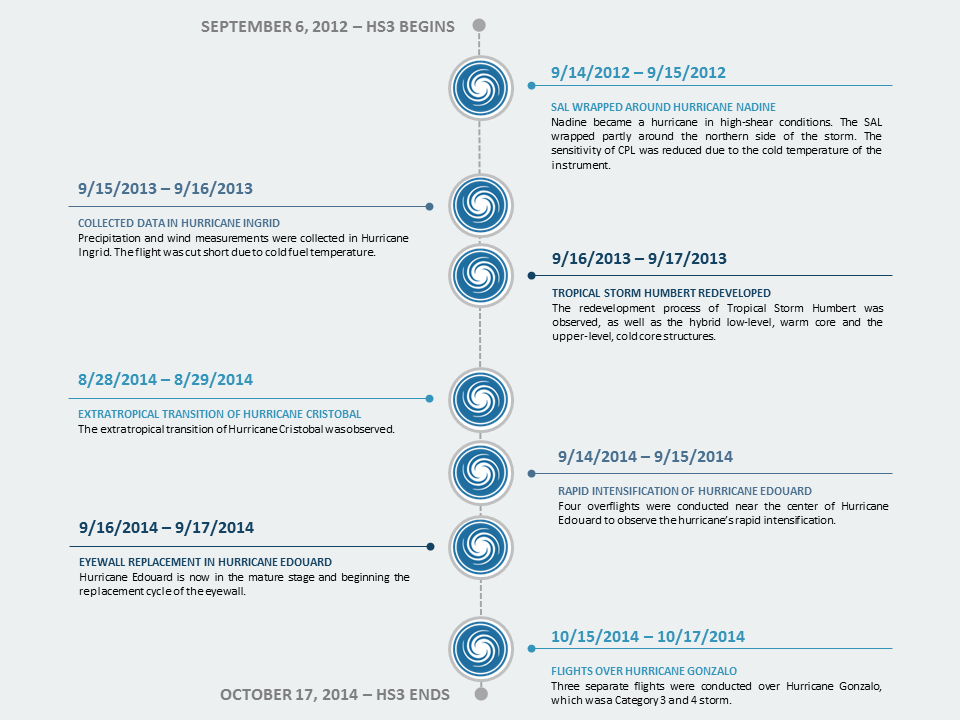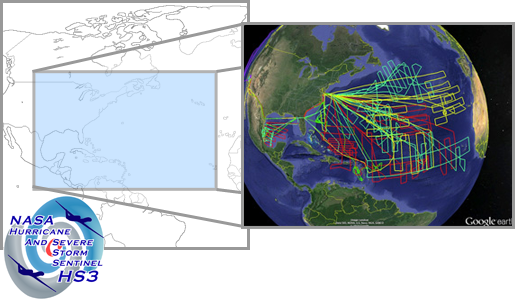Field Campaign Publication:
Braun, S.A., P.A. Newman, et al. (2016). NASA’s Hurricane and Severe Storm Sentinel (HS3) Investigation. BAMS, November 2016, 2085-2102. doi: https://doi.org/10.1175/BAMS-D-15-00186.1
HS3 Notable Publications:
Abarca, S.F., M.T. Montgomery, et al. (2016). On the Secondary Eyewall Formation of Hurricane Edouard (2014). Monthly Weather Review, 144, 3321-3331. doi:
https://doi.org/10.1175/MWR-D-15-0421.1
Komaromi, W.A. and J.D. Doyle (2017). Tropical Cyclone Outflow and Warm Core Structure as Revealed by HS3 Dropsonde Data. Monthly Weather Review, 145, 1339-1358. doi:
https://doi.org/10.1175/MWR-D-16-0172.1
Munsell, E.B., J.A. Sippel, et al. (2015). Dynamics and Predictability of Hurricane Nadine (2012) Evaluated through Convection-Permitting Ensemble Analysis and Forecasts. Monthly Weather Review, 143, 4514-4532. doi:
https://doi.org/10.1175/MWR-D-14-00358.1
Munsell, E.B., F. Zhang, et al. (2017). Dynamics and Predictability of the Intensification of Hurricane Edouard (2014). Journal of the Atmospheric Sciences, 74, 573-595. doi:
https://doi.org/10.1175/JAS-D-16-0018.1
Raymond, D.J. (2016). The effects of moist entropy and moisture budgets on tropical cyclone development. Journal of Geophysical Research, 121:16, 9458-9473. doi:
https://doi.org/10.1002/2016JD025065
Rogers, R.F., J.A. Zhang, et al. (2016). Observations of the Structure and Evolution of Hurricane Edouard (2014) during Intensity Change. Part II: Kinematic Structure and the Distribution of Deep Convection. Monthly Weather Review, 144, 3355-3376. doi:
https://doi.org/10.1175/MWR-D-16-0017.1
Zawislak, J., Haiyan J., et al. (2016). Observations of the Structure and Evolution of Hurricane Edouard (2014) during Intensity Change. Part I: Relationship between the Thermodynamic Structure and Precipitation. Monthly Weather Review, 144, 3333-3354. doi:
https://doi.org/10.1175/MWR-D-16-0018.1
Background Hurricane Information:
Braun, S.A. (2010). Reevaluating the Role of the Saharan Air Layer in Atlantic Tropical Cyclogenesis and Evolution. Monthly Weather Review, 138, 2007-2037. doi:
https://doi.org/10.1175/2009MWR3135.1
Didlake, Jr., A.C., G.M. Heymsfield, et al. (2015). The Coplane Analysis Technique for Three-Dimensional Wind Retrieval Using the HIWRAP Airborne Doppler Radar. Journal of Applied Meteorology and Climatology, 54, 605-623. doi:
https://doi.org/10.1175/JAMC-D-14-0203.1
Kelley, O.A., J. Stout, et al. (2005). Tall precipitation cells in tropical cyclone eyewalls are associated with tropical cyclone intensification. Geophysical Research Letters, 31(24), L24112. doi:
https://doi.org/10.1029/2004GL021616










